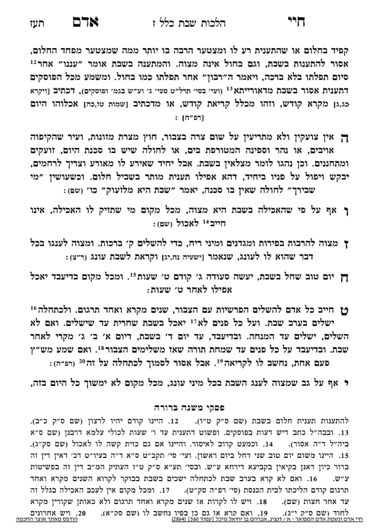The current series, which will cover seudos Shabbos and fasting on Shabbos, is available for sponsorship. Please contact Rabbi Reingold for more information.
We are continuing in siman 9, where the Chayei Adam discusses being maavir sedra. The Chayei Adam discusses relying on the public laining to fulfill part of a person’s chiyuv of shnayim mikra. The Chayei Adam writes that bedieved, one can rely on the public laining, but lechatchilla it is assur to rely on it.
It is important to note that not all achronim agree. Some hold that the entire chiyuv of shnayim mikra is to read the parsha separately from the tzibbur, so one cannot be yotzei with the tzibbur even Bedieved.
However, it is important to note that the Chayei Adam is not discuss reading along with the baal korei, but listening and being yotzei with shomeah k’oneh. We know that in many situations, one can be yotzei with shomeah k’oneh. In this situation, the Chayei Adam holds that bedieved one is yotzei but lechatchilla one should not rely on it, and some hold that one is not yotzei even bedieved. But, in regards to reading along with the baal korei, the Mishnah Berurah appears to have two approaches. In the halachos of krias hatorah, he brings the opinion of the Gra (among others) that a person is not allowed to read along with the baal korei. However, the Shulchan Aruch over there seems to be of the opinion that a person is allowed to read along with the baal korei, and the Mishnah Berurah concludes that in a case of bedieved, one can read along with the baal korei and be yotzei in that manner.
In the halachos of shnayim mikra, the Mishnah Berurah does not bring the Gra at all, and rather writes that a person may be yotzei through reading along. However, given that he brings the opinion of the Gra in Hilchos Krias Hatorah, it is appropriate lechatchilla not to read along.
When a person does read along with the baal korei, they will be reading the entire parsha in one shot, rather than breaking it up pasuk by pasuk. Thus, we see that one can be yotzei if they read shnayim mikra by reading through the entire parsha, repeating, and then learning Unkelos.
However, this is not the preferred way to fulfill the mitzvah of shnayim mikra. The Arizal writes that the preferable option is to read each pasuk twice and then the Unkelos. The purpose of shnayim mikra is to become familiar with the pesukim, so this method would seem to be the most successful.
The Beis Yosef wrote a sefer called Maggid Meisharim. He had a malach who would come down from shamayim to teach him Torah, and he recorded what he learned in this sefer. In one place he writes that he was admonished by the maggid that he should spend more time on each pasuk, because the point of shnayim mikra is not just to fly through the pesukim but to spend time understanding them. Therefore, it would seem to make most sense to read it pasuk by pasuk. We will see that preferably, the Shulchan Aruch writes that one should learn Rashi on the pasuk as well.
Another opinion brought is the Gra, who holds that a person should read it parsha by parsha. Parsha does not refer to the entire parsha of the week, but rather the paragraphs in the Torah, as defined by a “pei” or “samech” (i.e., a space in the Sefer Torah which delineates a new paragraph). Such a person would read each parsha twice, then the Unkelos and then Rashi, if possible.
Some parshiyos of the week do not have paragraphs, including Vayeitzei and Mikeitz. In those cases, according to this opinion, a person should stop at a place which seems like a logical break.
We have two reasons why a person should not be yotzei shnayim mikra with the baal korei. One is that the Gra holds a person is not allowed to read along and with shomea k’oneh only it is debatable if one out yotzei even bedieved, and the other is that it is a less preferred method of going through the parsha. Nevertheless, bedieved, if one read along they are certainly yotzei.
Summary
- One should not rely on the laining of the baal korei, but bedieved one is arguably yotzei.
- If one read along, they are yotzei.
- This option is not lechatchila.
- It is preferable to learn the parsha pasuk by pasuk, or at least paragraph by paragraph. If one goes through the entire parsha, they are yotzei as well.



